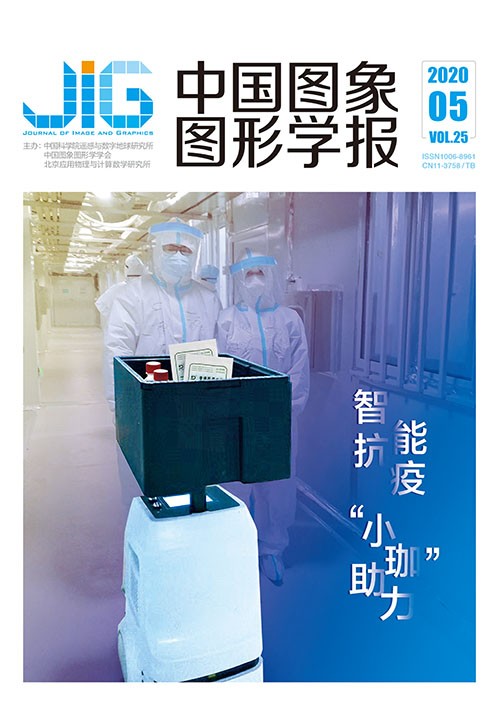
保持区域平滑的3维动画形状高效编辑
摘 要
目的 基于控制单元的形状编辑效果受各个控制单元对应权重的影响,而计算闭合形式的控制点权重方法难以有效地处理控制骨骼权重。针对3维空间的控制骨骼提出了一种虚拟控制单元插入算法和骨骼关节点标架变换方法,以保持骨骼控制区域的形状,从而得到过渡平滑、形状保持的良好编辑效果。方法 选择C2连续的线性权值计算方法,在用户输入相应的控制单元后,根据控制单元的支持度插入满足条件的虚拟控制点,实现了对动画形状平滑高效的编辑。首先采用离散化的方式,近似求解输入形状构成的封闭域中任意两点之间的内部距离,然后进行Voronoi区域分解,初步获得每个控制单元的控制区域。如果控制点的支持度约束不符合要求,则通过插入虚拟控制点的方式进行调整,并根据邻接关系计算实控制点对虚拟控制点的权重实现实控制点对虚拟控制点的控制。由于算法计算权值和编辑更新顶点可以并行,因此引入图形处理器(graphics processing unit,GPU)实行并行化处理。结果 实验对比了算法在编辑细节以及对不同网格模型的适应性和编辑效率方面的表现,结果表明本文算法在局部细节处不发生过度形变且保持平滑,对非三角网格和多个封闭区域叠加的网格模型依然适用,且本文算法不需要迭代,又有GPU并行计算,编辑时间显著下降。结论 本文算法易于实现,编辑效果过渡平滑,保留细节特征;GPU并行计算极大提高效率,达到实时交互效果。
关键词
Efficient 3D animation shape manipulation with region smoothness preservation
Xian Chuhua1, Yang Yu1, Huang Junxian2, Li Guiqing1(1.School of Computer Science and Engineering, South China University of Technology, Guangzhou 510006, China;2.NVIDIA Semiconductor(Shenzhen) Co., Ltd., Shenzhen 518057, China) Abstract
Objective Shape editing has been extensively researched for its applications in the fields of computer graphics and computer animation. Shape editing methods based on control units are widely used because they are intuitive, effective, and easy to implement during operation on animation characters. Generally, for an input 3D animation shape, the editing method first establishes the relationship between the shape and control units. It then calculates the weights of the points on the shape affected by each control unit and completes shape editing by applying transformations on the control units and updating the points on the shape by a linear combination of the control units with the pre-computed weights. Usually, the editing result depends seriously on weight calculation. Although numerous methods of weight computation have been introduced, most of them cannot effectively or efficiently handle control skeletons. In addition, the linear combination of rotation is no longer a rotation. Thus, the transformation of 3D skeletons is very complicated, and the transformation of local frame at bone joint points is difficult to determine. In this study, our proposed algorithm is aimed at editing 2D images, from 2D domain to 3D domain. In our editing method, the control units are classified into real units (or user-defined units) and virtual units. The virtual control units are generated by our virtual unit insertion algorithm. A novel insertion algorithm of virtual control unit is developed for the control skeletons in 3D space. An improved transformation method of skeleton joint point frame is also proposed to maintain the volume of the shape around the joint points of the skeletons, resulting in naturally smoother editing results. Method To achieve a smooth editing result, we utilize the Bezier function with 5° as the basic function for weight computation because of its C2 weighting properties. The virtual control points based on the C2 continuous weight calculation function are inserted into the input model based on the pre-input control units. The points of the shape are then controlled by the virtual and real control points, thereby realizing a smooth and efficient shape editing algorithm. The proposed method mainly includes several key steps: 1) calculating the internal distance for region decomposition, 2) inserting virtual control units, and 3) calculating control weights. The input 3D shape is voxelized. Next, the internal distances of the points on the shape and the control units are computed in the closed 3D space. The 3D space is decomposed into different parts according to the internal distances to obtain initial control region of each control unit. In our method, the support domain of a control point is also defined to achieve intuitive editing results. No other control point should be in a determined support region. If the regions do not satisfy the constraint of control point support domain, the insertion of virtual control points is required. In this work, the control units are divided into two classes: control points and control skeletons. The virtual control points inserted according to the pre-input control points become the first class of virtual control points, whereas the ones inserted according to the control skeletons are called the second class of virtual control points. When editing a 3D shape, the virtual control points cannot be directly operated by the user. Therefore, the transformation rules of the virtual control points following the real control points are also defined. 1) For the first type of virtual control points, the transformation is general translation and rotation. 2) For the second class of virtual control points, the local frame must be constrained to have an axis along the skeleton direction during transformation. When all support domains of the control units fulfill the constraints, the transformation of the real and virtual control points is then determined by solving a sparse linear system. Finally, the weights of all control points (including real and virtual control points) on the points of the 3D shape are computed using the C2 weighting function. During the editing process, users can conduct transformations on the real control units, and the input shape will be updated by setting new coordinates of the points on the shape with the transformation propagations of the control units. In our pipeline, the distance computation, weight computation, and shape updating steps can be computed in parallel. Thus, we incorporate graphics processing unit (GPU) to conduct the computations in these steps, which accelerate the computation significantly. Result In this study, we compare our method with existing methods: the SR-ARAP(smooth rotation as-rigid-as-possible) method, and Enhanced-ARAP(smooth rotation enhanced as-rigid-as-possible) method. Our experiments mainly compare these algorithms according to four aspects: editing details, adaptability of the algorithm to the non-triangular mesh models, multiple closed-domain overlay models, and computation time of the editing process. Experimental results show that the proposed algorithm never over-deforms and maintains smooth local details of the model, especially the shape around the control skeleton region. For the non-triangular mesh model and multiple closed-domain overlay models, the proposed algorithm is still applicable. However, the other two algorithms are not adaptive. Importantly, our algorithm requires no iteration, and due to GPU parallel computation, the editing efficiency is significantly improved. Conclusion Our proposed method is easy to understand and implement. The editing effect is natural, intuitive, and smooth, and the model details can be preserved quite well. Thus, the proposed method satisfies the general requirements of 3D shape editing. At the same time, the algorithm efficiency is greatly improved given the GPU parallel computing, which delivers feedback to the user operation faster. It basically achieves the effect of real-time interaction and thus improves user experience.
Keywords
|



 中国图象图形学报 │ 京ICP备05080539号-4 │ 本系统由
中国图象图形学报 │ 京ICP备05080539号-4 │ 本系统由